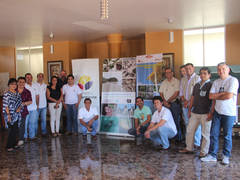Ecuador and Peru work towards the first transboundary Biosphere Reserve in South America
The proposal for the first transboundary biosphere reserve in South America made progress on 2 August, when key stakeholders met in Macara, Ecuador, to discuss the nomination file. Representatives of the Ministry of Environment of Ecuador and of the National Service of Natural Protected Areas in Peru worked together on the proposal, with the support of specialists from the German cooperation (GIZ), the NGO Naturaleza y Cultura Internacional, and the UNESCO Offices in Quito and Lima.
The presidents of Ecuador and Peru made a joint decision to propose the creation of a transboundary Biosphere Reserve during the presidential meeting and XI Binational Ministerial Cabinet meeting in Jaen, Peru, in December 2015. This new biosphere reserve proposal would include the Bosque Seco Biosphere Reserve in southern Ecuador, designated in 2014, and the Noroeste Amotapes - Manglares Biosphere Reserve in northern Peru, designated in 1977 and extended in 2016.
This process is being carried out in the framework of the project “Biosphere Reserves as a Tool for Coastal and Island Management in the South-East Pacific Region” (BRESEP), which is coordinated by the MAB Programme and supported by the Flemish Government of Belgium.
The overall objective of BRESEP is to create and reinforce existing biosphere reserves on the coastal areas and islands of the west coast of Chile, Colombia, Ecuador, Panama and Peru. The project also aims to promote biosphere reserves as tools for innovative projects to bring added value to local socio-economical activities, and to sensitize and build the capacity of stakeholders in the area.
The nomination file is expected to be finalized over 2 further meetings in the coming weeks, and submitted to the Secretariat of the Man and the Biosphere programme (MAB) in September 2016. Such proposals are then evaluated by an Advisory Committee, which issues a recommendation. The final decision to include a new Biosphere Reserve in the network is then made by the International Co-ordinating Council (ICC) of the MAB.
Related links
<- Back to: Natural Sciences


